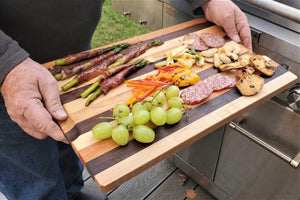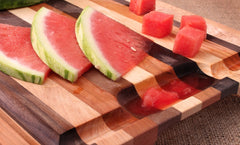- Continue Shopping
- Your Cart is Empty
Wood Carving or Cutting Board? Here are the FAQs.
What’s the difference between cutting boards and carving boards?
While you can use both types of boards for many of the same things, cutting boards are generally more for chopping where carving boards are typically for slicing meat and include a drain for the juices. Ideally you want a reversible cutting board with one side for each action.
Are wooden carving boards just for cutting meat and poultry?
Meat carving boards are perfectly designed for slicing roasts, hams and turkeys but they can also be really handy when cutting up juicy fruits and vegetables like pineapples, melons and tomatoes.
How often will I need a meat cutting board?
Buy the right wooden carving board, and you will use it every day. Even if you only pull it out a few times a year—anyone who’s tried carving a roast on a flat cutting board knows what a disaster that can be, with juices dribbling onto the counter from all sides. Carving boards are designed to avoid this mess, traditionally by relying on a trench or juice ring around their perimeter that traps and holds the liquid.
What’s the best size for a wooden carving board?
Depending on the size of your kitchen counters, the ideal length and width is usually 20'' by 14''. Longer or wider sizes add unnecessary weight and also make the carving board hard to store. Oversized carving boards can be very difficult to wash if they don’t fit into your kitchen sink. A 20'' meat carving board will easily hold a midsize turkey or a 5 lb roast.
As for height or thickness, your carving board should generally be around 0.75'' inches. It should be thick enough to sit securely on the counter, but still easy to lift. Thinner boards are much easier to store and wash than thicker cutting boards, but they are also more likely to slip on the counter.
What’s does the juice ring or trench do on my wooden carving board?
The juice ring or trench on a carving board is designed to trap at least 1/2 cup of liquid, roughly the amount released by a midsize turkey as it rests. This keeps juices off the counter and the food from sitting in a puddle on the board. This is an exceptionally handy feature whether carving up the Sunday roast or slicing juicy fruits for summer fruit salads.
What other features do I want for my carving board?
Many wooden carving boards have raised pyramid points that puncture the meat to keep it in place while carving or a well where the meat can sit securely.
Meat cutting boards should be reversible without metal spikes getting in your way. Reversible carving boards are a must have for cutting and chopping.
What about knife marks on my carving board?
Black Walnut, Cherry or 3 wood combination boards (Cherry, Black Walnut, Maple) hide knife marks and become a richer color over time making them amazing heirloom pieces for the kitchen/dining room. Knife marks will show up as black marks immediately on Maple or any light colored meat cutting board. To ensure your wooden carving board retains its optimal quality and appearance, it’s a good idea to periodically treat it with food-safe mineral oil.
How to safely clean wooden carving boards
Wood Carving Boards are not dishwasher safe. So choosing a board with the right dimensions is important for clean up. Juice grooves that are too narrow also make clean up difficult. Here’s more information on how to properly clean your wooden carving board.

from

Wood Cutting Board Famous Design Hides Knife Marks
from $ 109.99

from







